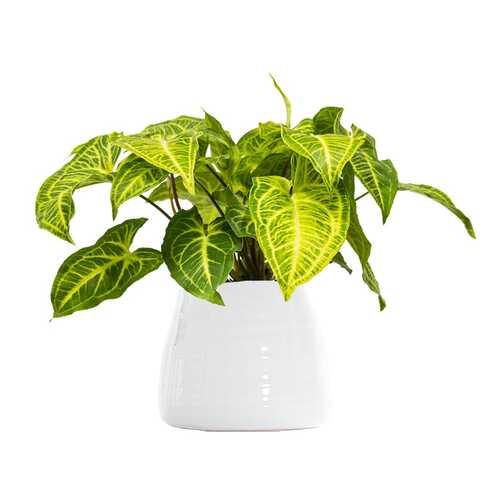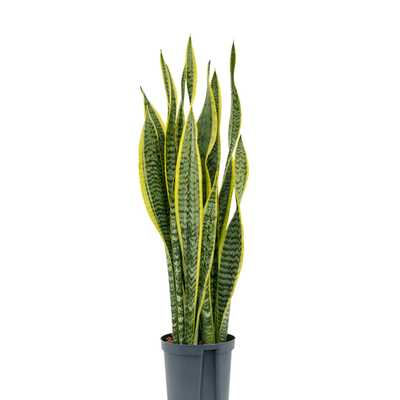Call US : 989124548005
Syngonium’s
0 USD
Short Description:
The visually-appealing plant can be trained to grow upright, but by pruning the upper leaves, it can be encouraged to grow horizontally and shaped according to your preference.Podophyllum
Syngonium’s overall features:
With spear-shaped leaves showcasing a vibrant green hue, Syngonium plants truly captivate the eye with their stunning aesthetic appeal.
The evergreen climbing vine can serve as an excellent choice for indoor gardening. It usually grows to 3’-6' long.
The visually-appealing plant can be trained to grow upright, but by pruning the upper leaves, it can be encouraged to grow horizontally and shaped according to your preference.
Syngonium plants are renowned for their exquisite beauty, ability to thrive in low-light settings, and their remarkable adaptability to different environmental conditions.
These plants exhibit rapid growth and boast lush foliage that adds a touch of elegance to any space they inhabit.
The gorgeous plant has various common names such as goosefoot, arrowhead plant, arrowhead vine, and arrowhead philodendron.
Origin:
Syngonium belongs to the Araceae family and is native to Central America and rainforests.
Light requirements:
This plant is recognized for its ability to withstand low light conditions; however, it has the potential to flourish and exhibit stunning leaf colors when exposed to higher levels of light, particularly filtered light. To promote optimal growth, the plant ideally needs approximately 1 to 2 hours of filtered light each day.
When caring for a Syngonium in an apartment, it's crucial to consider light conditions. Syngoniums should be kept away from direct sunlight for optimal growth.
Syngoniums, with their ability to thrive in low-light conditions, are perfect for adding a touch of tropical beauty to your living space.
Watering
This plant does not need to be watered frequently. It is recommended to let the potting soil dry out about one finger deep (1 to 3 centimeters) before watering. It is important to avoid following a fixed watering schedule as the frequency may vary depending on seasons: once a week in hot times and once every 10-14 days in cold season.
For optimal results, it is best to use salt-free water at room temperature. If tap water is being used, it is advisable to let it sit for four hours to allow any chlorine to dissipate before using.
Proper soil:
Syngonium thrives in a light soil mixture. An ideal blend can consist of garden soil, peat moss, perlite, and a small quantity of sand or cocopeat. It is preferable to use acidic soil.
To promote healthier growth and more vibrant leaf color, dissolve a teaspoon of humic acid every three months and apply it to the pot.
To ensure optimal growth, it is recommended to utilize a balanced, water-soluble fertilizer that offers essential nutrients. Here are a few options:
All-purpose liquid fertilizer: Syngoniums benefit from a balanced, all-purpose liquid fertilizer with an NPK ratio of 10-10-10 or 20-20-20. Dilute the fertilizer as per the package instructions and apply it every two to four weeks during the growing season.
Organic fertilizers: If you prefer organic alternatives, compost or well-rotted manure can serve as natural fertilizers for your plant. Apply a thin layer of compost or manure around the plant's base, ensuring no direct contact with the stems or leaves.
Slow-release granular fertilizer: Opting for slow-release fertilizers provides a consistent nutrient supply over an extended period. Look for granular fertilizers specifically designed for houseplants or foliage plants. Adhere to the package instructions regarding application rates and frequency.
Humidity and temperature:
This tropical plant prefers a humid environment. Using a humidifier or placing the plant on a tray filled with water can help provide the desired moisture level. Increasing the humidity in the room will generally benefit the plant.
For good growth, it is recommended to maintain a room temperature environment. During winter, the temperature should not fall below 2°C; while in summer, it should not exceed 32°C. However, pink species generally thrive better in cooler air conditions.
It is crucial to dust the leaves of plants, but it's important to avoid doing so when there is direct light shining on them, as this can lead to stains on the leaves. Instead, use cooled boiling water for dusting.
Note:
Containing calcium oxalate crystals, the plant is toxic to human and animals. If chewed or swallowed, it can cause tingling and swelling in lips, mouth and tongue.
Seek Expert Advice:
If you have any specific concerns or issues with your plant, it's advisable to consult a flower and plant expert. You can contact us for some professional advice.
Brief Overview:
Botanical Name: Syngonium podophyllum
Family: Araceae
Plant’s classification: Ornamental houseplant
Requirements: typical room temperatures, moderate watering, relatively high humidity, and well-draining soil
| Colors : | Albovirens, Pixie, Pink |
Product Reviews
Similar Products
List of similar products that you can see

Yucca’s
0 USD

Yocca
0 USD

Zamioculcas Zamiifolia
0 USD

Syngonium’s
0 USD

Spathiphyllum
0 USD

Schefflera
0 USD

sansevieria
0 USD

Pothos Silver Splash
0 USD

Pothos adanson
0 USD

.jpg)
.jpg)
.jpg)
